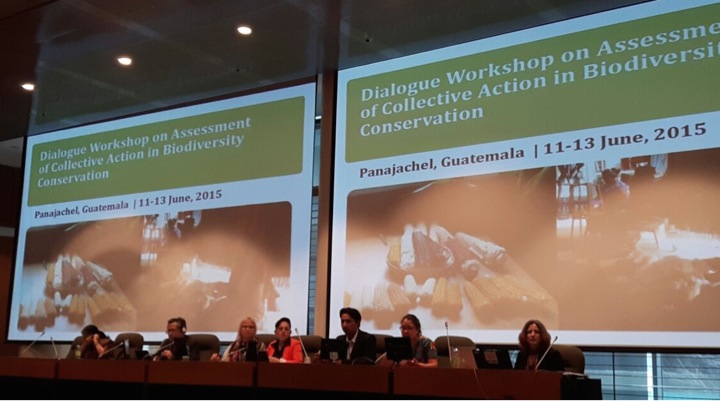 Story highlights
Story highlights
- Indigenous peoples and local communities contribute to biodiversity conservation by collective action that is based on their traditional knowledge
- A dialogue workshop helped to develop methods on how to assess and include values of collective action beyond monetary values in reporting for resource mobilisation under the Convention on Biological Diversity (CBD); and how to measure collective action of indigenous and local communities' contribution to biodiversity conservation and sustainable use
- At the negotiation meeting Subsidiary Body on Implementation (SBI 1) of the CBD the subject was negotiated, and a side event on the findings was held to inform the negotiations
Collective action is commonly understood as two or more people working cooperatively together towards a specific common goal. The role of collective action by indigenous peoples and local communities for biodiversity conservation was recognised in the decision on resource mobilisation at the 12th meeting of the Conference of the Parties (COP12). Bolivia proposed a framework (funded by SwedBio) for the conceptualisation and measurement of the contribution of collective action to biodiversity conservation and sustainable use for inclusion in the CBD Financial Reporting Framework.
Dialogue Workshop
In order to follow up on this decision and find diverse ways to carry it out, the “Dialogue Workshop on assessment of collective action in Biodiversity Conservation” was organised by SwedBio at Stockholm Resilience Centre and the Secretariat of the Convention on Biological Diversity (SCBD) together with local hosts in Guatemala, the National Council of Protected Areas (CONAP) and Asociación Sotz´il. The contribution of collective action and customary sustainable use by indigenous peoples and local communities to biodiversity conservation was also recognised in several other CBD decisions at COP12 such as on Article 8j on traditional knowledge, and Article 10c on customary sustainable use.
The side-event panel at CBD SBI 1 discussed the main issues coming out from the “Dialogue workshop on collective action” in Guatemala, June 2015. From left: Joji Carino, FPP; Yibin Xiang, SCBD; Pernilla Malmer, SwedBio; José Luis Echevarria Tello, CONAP, Guatemala; Sorka J. Copa Romero, Ministry of Foreign Affairs, Bolivia; and the co-facilitators, Juliana Upun, Sotz´il, Guatemala and Maria Schultz, SwedBio. Photo: Athing Lungharwo
Reporting and indicators under Aichi Targets
At the side event, “Collective Action by Indigenous peoples and local communities – Reporting and Indicators under Aichi Targets including the financial reporting framework”, Juliana Upun, Sotzi´l, Guatemala, and Maria Schultz, SwedBio at Stockholm Resilience Centre, explained that the purpose and aim of the dialogue in Guatemala had been to visualise the values of collective action and describe possible ways of measuring and aggregating both quantitative as well as qualitative data.
Characteristics of collective action
The facilitators asked the audience to reflect for a few minutes on what collective action of indigenous and local communities is and how it can contribute to conservation and sustainable use of biodiversity. They shared some of the viewpoints from the Guatemala dialogue.
Collective action – characteristics identified by the Guatemala Dialogue workshop
- Commonality – goals, values, decisions, resources, and efforts are shared by a group of people;
- Cooperation – actively working together, seeking to find benefits for the collective group, not just for the individual;
- Unity and interdependence are valued more than the differences between people;
- Support for the dynamics of the group – a willingness to find mutual agreements, compromising where necessary, and a recognition of mutual needs and reciprocity;
- Long-term vision – commitment to the process and the group, respect for culture, traditional institutions and customary law;
- Voluntary, not coerced, supporting a spirit of solidarity and empathy.
- Can help bring people together and provide strength to face external pressures;
- Beneficial and rewarding in itself – linked to people’s values, feelings of well-being and identity.
“From literature, we could summarise collective action to be ‘cooperation among two or more individuals to achieve outcomes that none of these individuals could achieve on their own; and to solve collective problems and choices at different levels,’” said Maria Schultz.
Non-monetary contributions
Outcomes of the Guatemala dialogue emphasise that the process of assessing, valuing and measuring the benefits of collective action and its contribution to biological diversity, must recognise multiple values. Whilst collective action might be reported in monetary terms, in most cases it would make a non-monetary contribution.
Many participants in the dialogue workshop further stressed that socio-cultural values cannot be measured adequately through monetary valuation, and that traditional knowledge can provide an important contribution on an equal level to scientific knowledge in decision-making and reporting processes.
Knowledge transfer
José Luis Echevarria Tello, from CONAP, Guatemala described collective action from a Guatemalan perspective, where the coevolution of culture and biological elements of importance in the livelihoods of indigenous peoples and local communities have been apparent over time. This also means that knowledge transfer over generations is critical to governance systems and institutions, as well as in promoting customary sustainable use, and to ensure the sharing of benefits from biodiversity resources with communities. This is now also being promoted in Guatemala’s effort to implement the CBD at the national level.
Evaluating the Contribution of Collective Action to Biodiversity Conservation
Sorka J. Copa Romero, Ministry of Foreign Affairs, Bolivia talked about the “Conceptual and Methodological Framework for Evaluating the Contribution of Collective Action to Biodiversity Conservation”, developed by the Government of Bolivia with the support of the Amazon Cooperation Treaty Organization (ACTO), and funded by SwedBio. The framework proposes a three-module approach, linking geospatial modelling, institutional analysis and ecological assessment.
Community-based monitoring systems
Pernilla Malmer, SwedBio at Stockholm Resilience Centre, Sweden described how methods for monitoring collective action are advancing, through the Indigenous peoples’ and local communities’ own work, to develop monitoring systems. Community-Based Monitoring and Information Systems (CBMIS) are a bundle of methods, developed by local communities based on their own monitoring needs, which are used for monitoring the indicators for traditional knowledge under the Convention. The initial aim with this monitoring is to strengthen the local knowledge base for territorial resource management and community development, but it can also contribute case studies and data for Aichi targets and other international commitments. For example, eco-cultural mapping, the ICCA Consortiums toolboxes and the efforts made by the “10c network”, and the “Outlook on biodiversity”.
Indigenous peoples and local communities need to be fully involved in the process of developing and applying methodologies for assessing their collective actions, from the onset to its application. Pernilla also presented the Multiple Evidence Base approach, as a method to ensure that indigenous peoples’ contributions are equally valid to scientific contributions in the process of working across the different streams of monitoring from different sources.
Cultural and biological diversity
Joji Cariño, Forest Peoples Programme, in her reflection from the dialogue, commented that the contribution by indigenous peoples’ and local communities’ collective action constitutes cultural and biological diversity. Before it was taken for granted, assumed to persist forever and to be available for free. Why is “the value of collective action” coming up as a priority for Aichi target 20 on resource mobilisation? Collective action contributes to the compliance of all the biodiversity targets. Resource mobilisation is mostly focused on financial resources, whereas the components of collective action are mostly non-monetary contributions. It is indeed important to make the contribution of collective action visible, but in particular as non-monetary contributions. She pointed to examples such as the work by SCBD and FPP: “Outlooks on Biodiversity Indigenous Peoples and Local Communities’ Contributions to the Implementation of the Strategic Plan for Biodiversity 2011-2020 – A Complement to the Fourth Edition of the Global Biodiversity Outlook.
Traditional knowledge
In the discussion that followed the presentations, it was reflected that traditional knowledge can provide an important contribution to decision-making and reporting processes. It was considered important for the ways and means of holding and transmitting traditional knowledge to be recognised and fully included when reporting on the contribution of collective action by indigenous peoples and local communities.
Indicators
Robert Hoff from the SCBD, reflected that they have seen a positive development in contributions from indigenous peoples and local communities in developing their own indicators, in bottom up approaches. However, he said it was still difficult to follow up and aggregate these across communities. He reflected that although it might be difficult to identify global indicators for collective action, there are many options to confirm their values locally. In some cases expert knowledge is lacking in national reports – Indigenous peoples and local communities might offer that expertise, as an input to the reports.
Next steps
- Collective action has cross-cutting relevance for all 20 Aichi Biodiversity Targets.
- Assessing collective actions may require investments, but offers many benefits, and could strengthen public policies.
- To materialise this, more Inter-cultural meeting spaces are required, and more time is needed for the process of including collective action in the resource mobilisation framework.
- It is also important to support Indigenous peoples and local communities and developing countries for measuring and reporting.
- Methodological pluralism and complementarity are necessary – different methodologies may generate different data that can be used as complementary sources of information.
- Bridging methodologies could bring together data on larger scales with bottom-up assessments that transmit significant aspects of the local cultural contexts and world views.
- Pilot projects should be encouraged and established to test multiple methodologies.
The CBD will follow up on guiding principles for reporting on collective action under the resource mobilisation framework in COP13.


